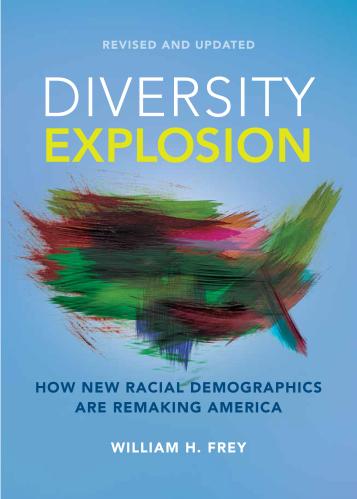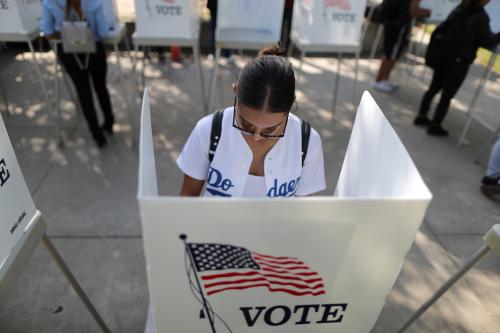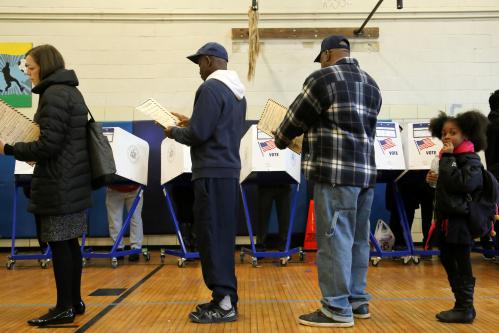Tuesday’s midterm House elections saw Democrats fare much better than they did in the 2016 presidential contest. Two years ago, Hillary Clinton topped Donald Trump by 4.6 percent in the popular vote, while this week, Democratic House candidates received 9 percent more votes than their Republican counterparts.
The 2018 exit polls indicate that a considerable share of Democratic gains came from shifts in white voting patterns, even as Democrats retained strong support from racial minorities. Moreover, in key Midwest statewide elections, Democrats lost fewer white working-class male votes while retaining support among white female college graduate voters.
Whites still voted Republican, but less so than in 2016
Race continues to represent a primary fault line in national elections. Whites overall continue to favor Republicans and minorities—especially blacks—continue to favor Democrats. This fault line is increasingly important in midterm elections as the nonwhite share of eligible voters grows, even though minorities are less likely than whites to turn out. The 2018 exit polls show that minorities—including blacks, Hispanics, Asians, and other nonwhite groups—constituted an all-time high, 28 percent, of midterm voters, and fully 38 percent of young adult (age 18 to 29) voters (Figure 1).

Among those who voted, partisan differences by race remained in 2018, but shrank from their 2016 levels. Comparing the national vote for 2018 House of Representative members with the 2016 presidential vote, the white Republican vote advantage decreased by half, from a D-R margin (percent voting Democratic minus percent voting Republican) of -20 in 2016 to -10 in 2018. In contrast, positive D-R margins (favoring Democrats) remained the same or increased for non-white groups (Figure 2).

Younger, female, and educated white voters helped Democrats on Tuesday
White voters are not a monolithic bloc, however, and the 2018 exit polls indicate shifts in partisan support by age, education, and gender that help explain Democratic gains.
Nationally, the total population under age 45 has favored Democrats in midterm House and presidential elections since 2010. Much of this is due to the larger minority presence among younger voters, because white young adults often vote Republican. This was the case in both the 2012 and 2016 presidential elections, but changed in the 2018 midterms.

In Tuesday’s elections, whites aged 18 to 29 registered a positive D-R voting margin of 13, and whites aged 30 to 44 flipped from a Republican vote advantage in 2016 to an even Democratic–Republican split (D-R margin of 0) in 2018 (Figure 3). Many have noted that stronger young adult turnout provided increased support for Democrats, but it is especially noteworthy that white young adults voted more strongly Democratic than in previous elections.
Perhaps even more important for Democrats on Tuesday were gender and education patterns in white voting. As political analyst Ronald Brownstein noted, white college educated women are a likely long-term Democratic-leaning voting bloc, in contrast to other white groups, especially white men without a college education. The latter group, in particular, arguably provided decisive support for Donald Trump in the 2016 election.
In contrast to that election, the 2018 exit polls show markedly reduced Republican support among white males without college degrees (from a -48 D-R margin in 2016 to -34 in 2018), and increased support for Democrats among white college educated women (from a +7 D-R margin in 2016 to +20 in 2018) (Figure 4).

Shifts in white voting patterns from 2016 showed up in battleground states
These national patterns of lower white voter support for Republicans in the 2018 midterms are also evident in selected senatorial and gubernatorial elections in states mostly won by Donald Trump in 2016, but where Tuesday’s election results were much closer (download Table A).
Common white voting shifts occurred in four Midwest industrial states, including gubernatorial elections in Michigan (won by Democrat Gretchen Whitmer) and Wisconsin (won by Democrat Tony Evers), along with senatorial elections in Ohio (won by Democrat Sherrod Brown) and Missouri (won by Republican Josh Hawley). In each of these states, strong Republican margins among white men without a college degree put the states in Trump’s column in 2016. While still substantial, those margins were considerably narrower in 2018, by at least 20 percentage points in each case. In Ohio, Missouri, and Michigan, Democratic support among white college educated women rose sharply, and in Ohio and Missouri shifted overall from Republican to Democratic support. (In Wisconsin, this group showed strong Democratic support in both elections.) Finally, in each of these states, minority Democratic support, while still strong, slipped slightly from 2016 levels.
Somewhat different patterns emerged in Sun Belt states with close outcomes. These include gubernatorial elections in Florida (won by Republican Ron DeSantis) and Georgia (still undecided between Democrat Stacey Abrams and Republican Brian Kemp), as well as senatorial elections in Nevada (won by Democrat Jacky Rosen) and Texas (won by Republican Ted Cruz). Florida’s shifts since 2016 come closest to those observed in the Midwest states, featuring markedly reduced Republican support among white men without a college degree (a nearly 30 percentage-point shift in D-R margin) and a dramatic flip from Republican to Democratic support among white college-educated women. Nevada, in contrast, showed modest Republican gains in most categories counting whites, except white college educated women who shifted from Republican to Democratic support.
Both Texas and Georgia, like several other southern states, show strong white Republican margins in both elections, but different shift patterns. In Texas, the Cruz-O’Rourke senatorial election resulted in reduced Republican advantages in three white categories, the greatest for women. In Georgia’s Abrams-Kemp gubernatorial contest, Republican advantages narrowed the most for college educated men and women, though no category of whites showed a Democratic advantage. Strong black turnout and support for Democrats vied with still-strong white Republican support to keep this election close.
For the nation as a whole and for key state midterm elections, reduced white Republican support, especially among white working class men, and Democratic gains among white college educated women, provided a stark contrast to 2016 election results. While racial minorities are essential Democratic voting blocs as the nation diversifies, these key shifts among segments of the white electorate will be important to watch moving forward.
The Brookings Institution is committed to quality, independence, and impact.
We are supported by a diverse array of funders. In line with our values and policies, each Brookings publication represents the sole views of its author(s).









Commentary
2018 exit polls show greater white support for Democrats
November 8, 2018